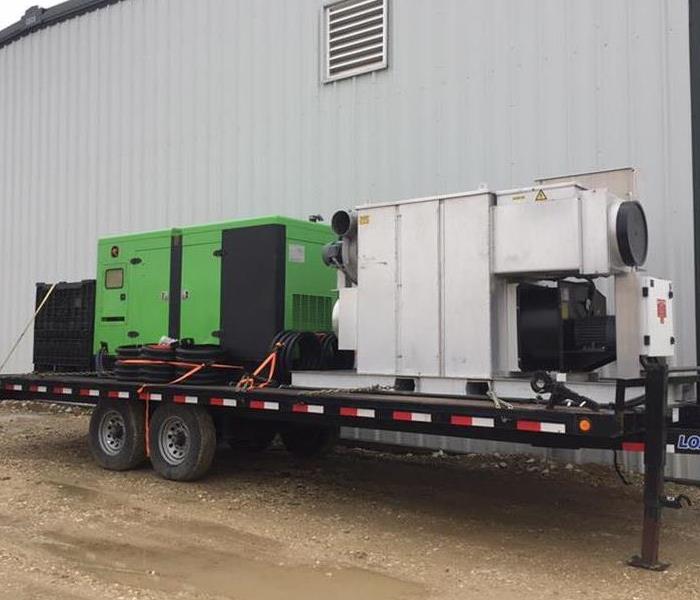Recent Water Damage Posts
Damage from a Leaking Toilet
10/25/2022 (Permalink)
A toilet leaking or overflowing can lead to water damage and possible containments in your residential or commercial space. A situation like this requires swift action and the right team doing the job. Luckily, SERVPRO of Iowa City/Coralville offers emergency services 24 hours a day and is committed to making a fire, water or storm disaster “Like it never even happened.”
There are various reasons why a toilet may leak, and steps should be taken immediately to prevent further damage. The supply line, which brings new water into the tank and is part of the flush mechanism, may become worn or cracked which leads to leaking. A malfunctioning flapper or valve could also be the culprit. If this happens in your property, make sure to turn off the water supply to prevent further damage. This can be found behind the metal supply line with the valve near the wall's connection point. Then, remove all the water from the tank.
Our SERVPRO team has the skills needed to handle a job of this type. We are able to safely clean an affected area and restore it after damage. We are here to help!
Sump Pump Failure, Can We Not?
7/15/2022 (Permalink)
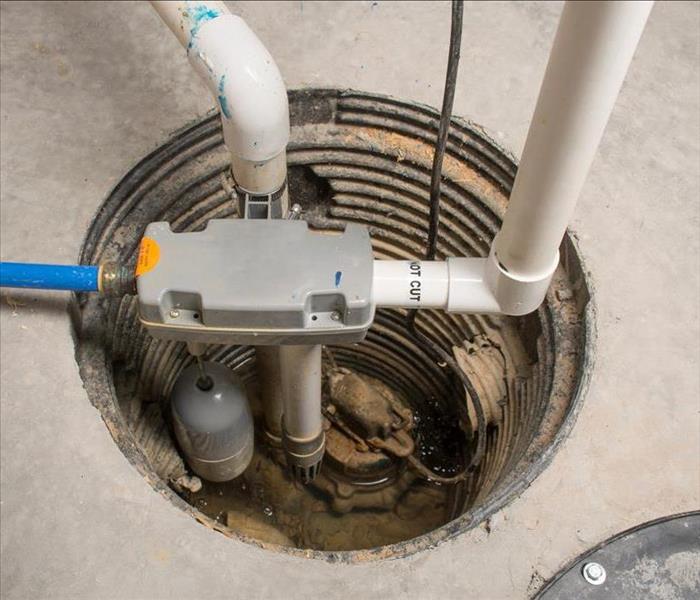 If you wake up to a flooded basement call our SERVPRO of Iowa City/Coralville office at 319-338-8550.
If you wake up to a flooded basement call our SERVPRO of Iowa City/Coralville office at 319-338-8550.
It’s Jacob, Digital Marketing Coordinator, and I recently went to the Job File Coordinator’s Office to ask them a simple question: What is Causing Our Water Jobs?
“Sump Pump Failures with all the rain we’ve been getting.” So I thought, let me explain some of the most common ways that cause sump pumps to fail.
The Clogged Discharge Pipe
If you haven’t checked your sump pump recently, I recommend checking to see if it is draining thoroughly. A lot of people run into the issues when the drain is clogged, and the flood water flows back down the pipe and into your basement. A simple way to combat this is by ensuring the opening of the discharge pipe has a grate. This prevents any chance of clog from forming.
Power Failure
The weather we’ve seen in the Midwest region has created the perfect situation to fail your sump pump. When intense storms pass through your area, it can cause power outages and excess rain. When you combine those two factors, you allow yourself to fall victim to a flooded basement. No power means the pump won’t work, causing the water backup. To avoid this, purchase a backup generator that allows you to turn it on manually.
Cupping... Warping… This is Nightmare
7/15/2022 (Permalink)
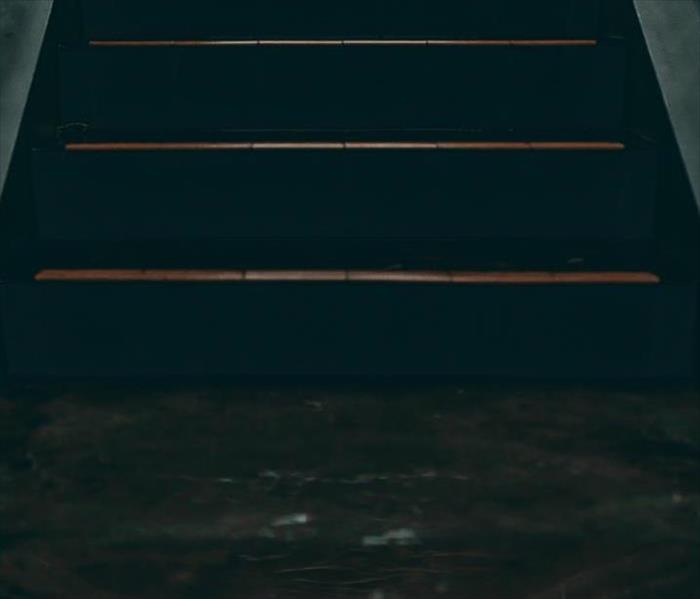 If you notice this type of damage please call our team at SERVPRO of Iowa City/Coralville at 319-339-8550.
If you notice this type of damage please call our team at SERVPRO of Iowa City/Coralville at 319-339-8550.
When our Project Managers go to a job site and the scope of the property, they are looking for multiple factors to present themselves. One of the most common indicators of this damage is cupping or warping.
Cupping is when the floor boards create a concave shape with higher sides than the center. Cupping is associated with a change in moisture content levels. Warping is more severe than cupping because it involves the floor buckling/popping off of the subfloor. Water vapors can cause this to happen.
If this doesn’t get taken care of by professionals, it can cause microbial growth from the layer of paper that goes in during the installation process to prevent squeaking. If you let this continue without restoration, it can permanently damage your floor.
The Method to Our Restoration Process
6/22/2022 (Permalink)
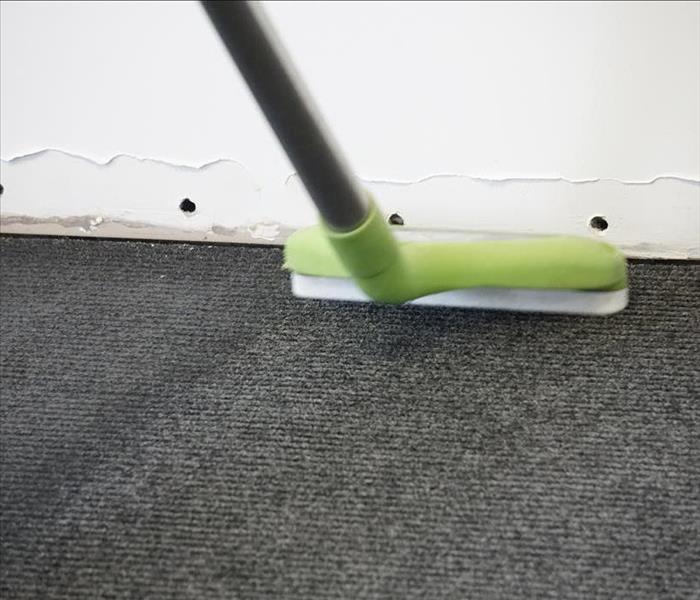 If you want your disaster to be handled the right way please call SERVPRO of Iowa City/Coralville at 319-338-8550.
If you want your disaster to be handled the right way please call SERVPRO of Iowa City/Coralville at 319-338-8550.
Recently we received a job from a client that dealt with a carpet that had water and pet damage which means we have to be strategic when restoring it to the preloss condition. The damage was deeply embedded into the carpet, especially with the extreme heat the Midwest has faced.
Do you know how we remove deeply rooted water/odor damage; well, we pour more water on it. You read that correctly; with deeply ingrained damage, we need to take the necessary steps, and our crew will create a structure by using collapsible sides lined with 6-millimeter plastic to create a bath. I know this is getting ironic; the bath is then added with our SERVPRO products, Urine Odor and Stain Remover, which gets soaked into the carpet for an hour, causing the severe stuck-on damage to be lifted and off the rug.
We don’t stop there; we use our rotary machine to agitate the rug even more, causing the remaining damage to be lifted off the ground. Once this process is completed, we empty the water and use the water claw to extract the rug, with the final step being providing a last cosmetic clean, restoring it to the preloss condition.
Melting Snow Creates Water Damage
2/11/2022 (Permalink)
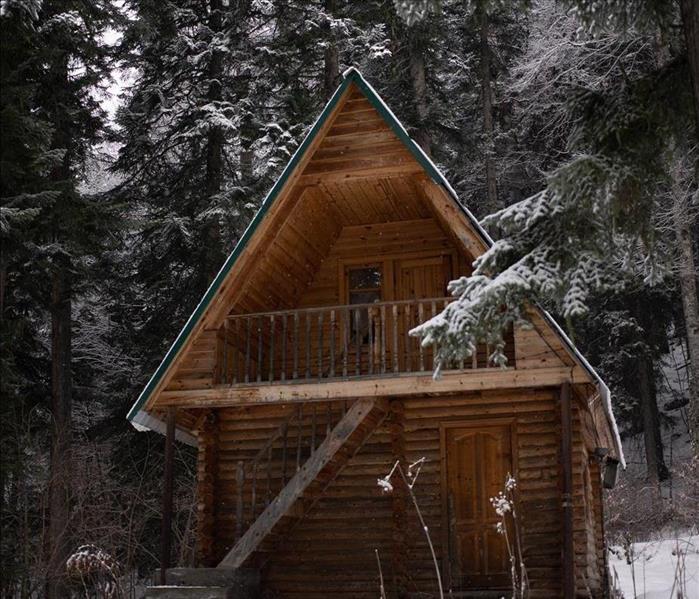 When shoveling, one should make a pathway so that all melted moisture can flow away from home.
When shoveling, one should make a pathway so that all melted moisture can flow away from home.
Living in the Midwest has taught us that one minute it could be significant snowstorms, and the next, it will be direct sunlight as if nothing had happened. People don’t connect with snow melting, and flooding issues as these types of floods aren’t as common. Flooding doesn’t occur unless the ice freezes near the structure, creating tiny cracks in the foundation. The problem begins when the chilly weather subsides, and now you have the perfect doorway into your home as water has a way to seep into the house.
Water Damage to the Carpets
During the winter, the water will seep into the cracks, which cause water damage to the drywall, flooring, or carpets. When it’s cold outside, we usually keep the temperature of our homes warmer than usual which helps microbial growth if the water reaches the carpet. The development will thrive in these conditions, especially if the homeowners don’t allow proper ventilation outwards. Still, if you follow these tips, you can help prevent unwanted disasters.
Tip 1: Be Strategic with Shoveling
When shoveling, you should be strategic in creating a pathway for the water to flow once it starts to melt. Meaning if your home is on a hill, find a way that eliminates the risk of large amounts of water-absorbing around the foundation of your home.
Tip 2: Clear Excessive Snow off of the Roof
When you don’t adequately remove the snow off of your roof, you are running the risk of having a ceiling collapse or, even worse, the creation of ice dams. When trying to prevent these ice dams, we advise you to get all snow off first and then get on the roof to evaluate the drains. This ensures you can clear any frozen blockage, which stops the problem before it begins.
Tip 3: Check Sump Pump
You can test your sump pump by pouring a bucket of water into the pump, which displays if it is working. Performing routine testings, you can help prevent flooding of the crawlspaces, around the foundation, and in the basement.
We have received a couple of samples of warmer days ahead on the bright side. Spring is right around the corner, which means even more ways for water to create problems for your home!
Removing Moisture from Materials
2/11/2022 (Permalink)
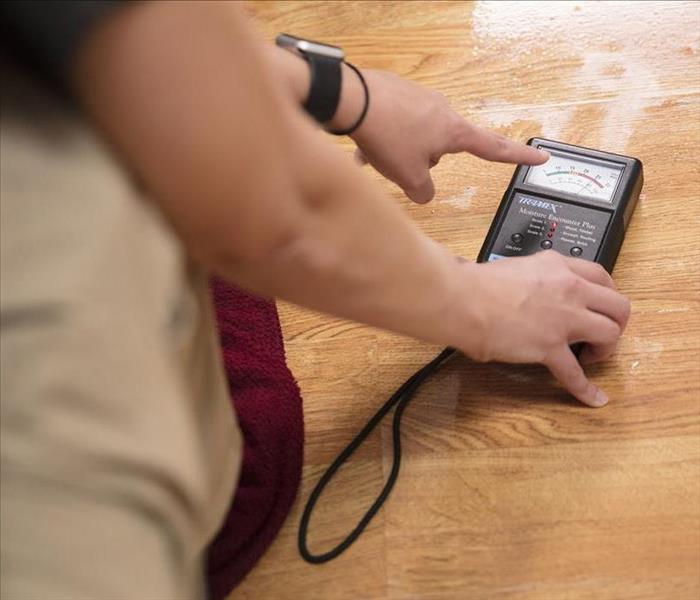 Our crew of professionals is prepared to use their knowledge to provide their clients with the best course of action.
Our crew of professionals is prepared to use their knowledge to provide their clients with the best course of action.
When our crew approaches a water job, we evaluate many different variables. All of which are very important, but there are two variables that we look at the most: type of material and the degree of wetness. This means that we will evaluate each material's permeability, the ability for water to pass through the material, dampness, the moisture movement. The liquids will be presented in one of these forms.
Surface Water
Like the name, you can find this type of moisture on the material's surface. It is a visible liquid and can evaporate. When mitigating this type of moisture, you must remove the moisture using mechanical extraction. The next component needed to be addressed: airflow, which helps control temperature and humidity, which helps evaporate any remaining moisture.
Free Water
Unlike surface water, the name of this absorption doesn't give you many clues on how to find it in a material. Before the moisture can form a chemical bond to the material, free water happens. You can find this type of moisture in cavities, open pores, and other air spaces within the material. When mitigating this form of moisture, you will want to use lower humidities and warmer temperatures. By maintaining these factors, you ensure that the moisture is going to evaporate.
Bound Water
More work is needed to fully mitigate this type of moisture material as this form is when the moisture has made chemical bonds. You will have to release it to get the moisture out of the material when this happens. Unlike the other categories, controlling the airflow won't help remove the chemical bonds. The moisture will dry fastest when it is warmed. The essential factor to keep in mind is maintaining the surrounding humidity. Keep in mind that this type will take the longest to dry out of all categories.
This is why you should hire our team of professionals here at SERVPRO of Iowa City/Coralville because we know what to look for. We evaluate each material to create a precious course of action to provide results and restore to the preloss condition.
Let's Prevent Some Ice Dams
1/5/2022 (Permalink)
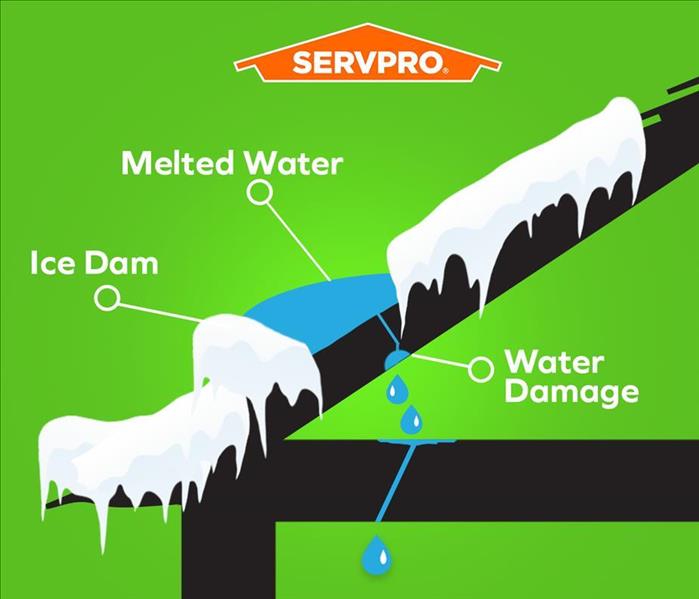 Know what to look for so you can prevent ice dams from forming on the roof of your home.
Know what to look for so you can prevent ice dams from forming on the roof of your home.
With the winter season here, we are preparing for frozen pipe burstings and water damage caused by ice dams on the roof. Ice dams are created when three components form the perfect conditions to ruin a homeowner's life. These components are a snow-covered roof, different temperatures at the top of the roof compared to the lower edges, and freezing temperatures.
The Perfect Conditions Equals the Perfect Wintery Nightmares
You might be wondering how a little ice can affect the roof's structure. This happens when the snow melts from the warmer areas and pools on the roof 32F or below. The water then finds the cracks in the surfaces and openings in the exterior roof coverings, seeping into attic space. Sometimes it won't stop there. The water can flow into exterior walls or through the ceiling insulation and stain the finish.
Nonuniform Roof Surface Temperatures
There are some crucial tips that you can implement to avoid a bigger disaster. Ice dams are created when two different surface temperatures are on the roof. This means that parts of the roof have a heating source on the interior, causing the different spots on the roof to be warmer than others. Heat travels from the home to the roof surface in these three ways: conduction, convection, and radiation.
- Conduction is when heat energy travels through a solid.
- Whereas convection is when heat/energy is transferred from rising air to your hand.
- Lastly, heat/energy can be transmitted by electromagnetic waves known as radiation.
The best way to avoid creating ice dams on your roof can be achieved in multiple ways. These are some of the steps that the homeowner could do to prevent ice dams from forming:
Limiting the Heating Source by Adding Insulation
As mentioned before, heat can move from the ceiling and insulation by conduction through the sloped portion of the roof. You should combat this critical access point by installing more insulation, precisely one with a high R-value per inch to keep heat inside the home.
Purchase A Roof Rake
If installing insulation isn't something you feel comfortable with, you could always hire SERVPRO; you can always purchase a rood rake. A roof rake is a tool you can use once the snow has stopped falling. You can extend the rake, which helps pull down access snow, allowing the roof to cut off the source of the damage.
If you find yourself in a winter wonderland of a mess, please reach out by CALLING US at 844-965-0001 or by calling the local Iowa City number 319-338-8550.
Floating (Magic?) Carpet
10/27/2021 (Permalink)
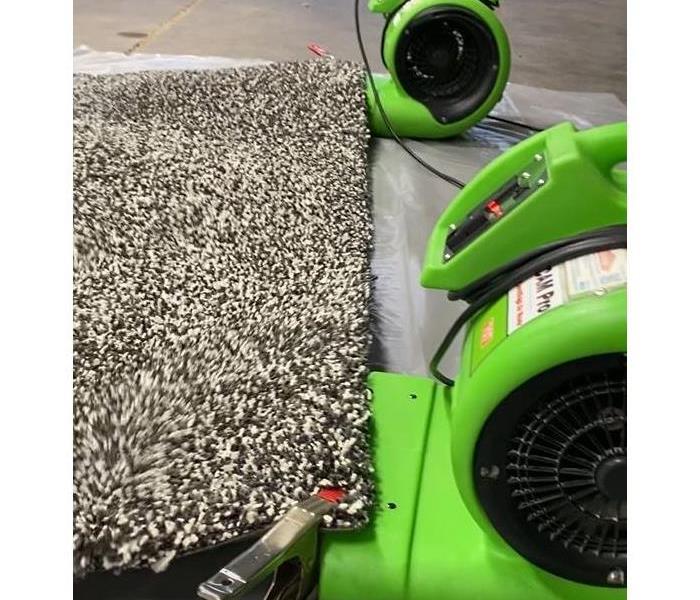 Air movers can be placed and clipped underneath the carpet to promote drying of the back part of the carpet. This is part of the drying process.
Air movers can be placed and clipped underneath the carpet to promote drying of the back part of the carpet. This is part of the drying process.
When water damage takes over, our team is ready to take your home back. If you have carpeting in your home, then it would be safe to say that one of your worst nightmares would be flooding or a leak that would soak and stain all your carpet. In this case, after water is properly extracted, the rest of the drying process can be continued. Whether we are placing air movers or you are renting your own, carpet can be “floated” where air movers are placed to blow air under the carpet. The air mover can be clipped to a section of the lifted carpet and the air creates this effect that is similar to the magic carpet in “Aladdin,” creating this flowing movement. If you are doing this on your own, make sure that you don’t have too many air movers putting air under the carpet at the same time. If there are too many air movers, the “floating” movement can become too aggressive and the carpet hitting the ground repeatedly can result in the tac strip separating from the backing. To ensure that your carpeting is maintained, please call on professionals to help. We have the equipment to make sure the job is done right and that we can get your home back to preloss conditions.
The Standard Water Damage Process
7/20/2021 (Permalink)
Every water damage job is different as there are different grades of water, different amounts, different floors and contents affected, and different causes. With that being said, we maintain a standard procedure to ensure the safety of the client and this allows us to build out the best call to action for every job.
Step 1: Emergency Contact
Cleanup and restoration begin with a phone call. We have a representative to answer your phone call 24/7/365. They will lead you through several questions to better understand your needs for the water event.
Step 2: Inspection and Damage Assessment
Our SERVPRO professional completes a detailed inspection of your property and determines the scope of the damage.
Step 3: Water Removal/Water Extraction
This step removes the majority of the water from your home or business.
Step 4: Drying and Dehumidification
Our team of professionals will manipulate temperature and relative humidity to remove the remaining moisture. Daily monitoring will occur until the materials reach an acceptable drying goal.
Step 5: Cleaning and Sanitizing
Walls, floors, and other surfaces of the property will likely need professional cleaning treatments once the area is dry. Restoring contents, odor removal, and deodorization, and sanitizing treatments occur during this step.
Step 6: Restoration
This is the final step in the process of restoring your property to its pre-water damage condition.
Why Do We Use Dehumidfiers?
7/19/2021 (Permalink)
We use dehumidifiers as one piece of equipment during our balanced drying system we utilize when we are cleaning up after a water loss. Our team members work to get the moisture out of the material, and they then use air movers and energy to get the water to evaporate. In some cases, though, with certain materials like hardwood, our team may need to dehumidify the material as well. While dehumidifiers can be strong enough to take water out of the air and can be effective enough to dry a room out quickly, we have other options.
We use dehumidifiers because sometimes they are the most effective option. We are available 24/7 for emergency disasters and can provide equipment to get your home or business back to preloss conditions
What to do about frozen pipes
2/18/2021 (Permalink)
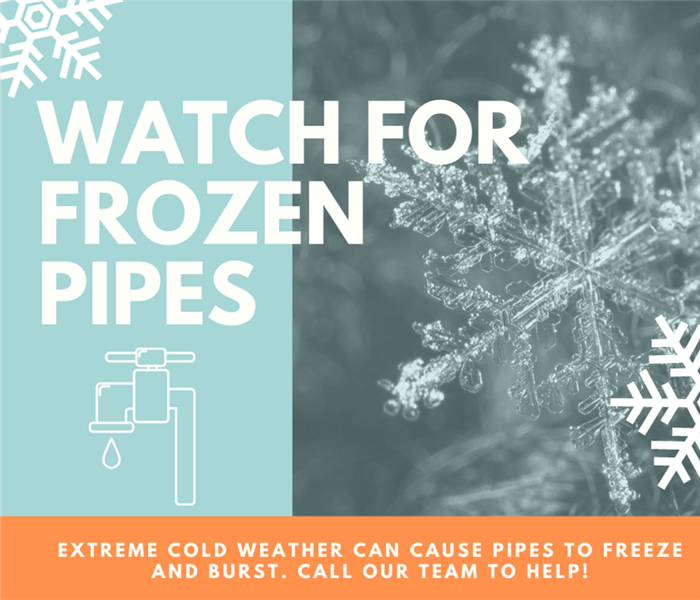 A burst pipe can cause a lot of water damage, so call on our team when you are experiencing the damage in your home or business.
A burst pipe can cause a lot of water damage, so call on our team when you are experiencing the damage in your home or business.
Frozen pipes can cause a lot of issues and cost a lot of money! One pipe burst in a home at 4-8 gallons of water running per minute. This can cause thousands of dollars worth of water damage. If not taken care of and mitigated properly, then this can then lead to mold issues.
Prevention:
- Locate and identify any and all shut off valves in the home and make sure they work properly. (Everyone should know where their "Main Water Valve" is at and how to operate it)
- Identify any potential problems. (Areas where pipes are on an outside wall, ceiling, attics, crawl spaces, etc)
- Seal any gaps around the home where cold air has a chance to come in contact with pipes. In extreme cold temperatures, especially wind driven, even a tiny opening can let enough cold in to cause a pipe to freeze. (Dryer vents, windows, cable penetrations, etc.)
- Turn off and drain all standard outside hose bibs.
When the temperature is expected to drop:
- Open kitchen sink and any vanity doors of the areas that are at risk for problems.
- With pipes that are on outside walls that may be a freeze problem, leave a small trickle of both of the hot and cold water running.
- Temporarily seal off any crawl space vents that may be around the foundation.
- Keep the house warm.
What to do if you experience a frozen pipe: (The first sign of a "frozen" pipe is reduced or no flow at all)
- If you experience a "no flow" situation (First turn off the "Main Water Valve" to the house and leave the faucets "open", Second DO NOT use any open flame to attempt to thaw the pipes, Third DO NOT use any electric heater, hair dryer applied directly to the piping as any leaking water may cause electrocution, and Forth turning the water back on is best handled with (2) people. One person turning on the water SLOWLY and the other walking about the house to be sure no water is running).
- Heat and patience is the best way to get frozen pipes thawed out. We do recommend that if a frozen pipe happens to find the source and correct it so it will not happen again. (If you were lucky enough for the frozen pipes not bursting this time, you may not be so lucky the next time.)
**Please be advised if the water to your house is shut off, it may also turn off any fire prevention system you may have hooked up to your water
What to do if you leave your home during the winter months:
- Turn the Main Water Valve off to your home**
- Leave the heat on to the house and set it NO LOWER than 60 degrees.
- Have a neighbor stop by daily, especially when the temperatures are in the 20's or lower.
**If your home has "hot water and/or steam heat", the water must remain on even when you are not there. A neighbor stopping by is critical if this applies to you.
The Principles of Drying
2/10/2021 (Permalink)
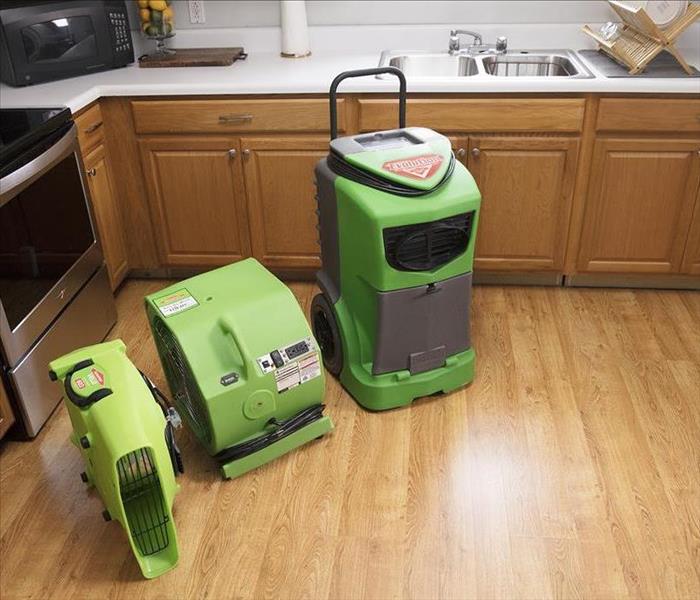 Our team of trained professionals utilize their expertise to make sure your home or business can get back to normal.
Our team of trained professionals utilize their expertise to make sure your home or business can get back to normal.
The restorative drying process is meant for restoration professionals and is designed to ensure that each component and variable is considered to achieve all drying goals.
Principle 1: Provide for the safety and health workers and occupants
Principle 2: Document and inspect the project
Principle 3: Mitigate further damage
Control the spread of contaminants
Control moisture intrusion
Principle 4: Clean and dry affected areas
Our team uses cleaning procedures whenever soils and debris must be removed to expedite the drying process. Restorative drying for professionals is used to control as many factors as possible to complete the most efficient drying process. Once enough water is extracted, evaporation is enhanced by:
- Lowering humidity
- Increasing airflow across wet surfaces
- Controlling temperature of air and surfaces
- Using outside air when possible
- Creating a drying chamber
Principle 5: Complete the restoration and repairs
Personal Protective Equipment
1/14/2021 (Permalink)
 No matter if it is mold, sewer damage, or water intrusion, we have the equipment needed to handle the situation efficiently and thoroughly.
No matter if it is mold, sewer damage, or water intrusion, we have the equipment needed to handle the situation efficiently and thoroughly.
We aim to provide our professional team members the necessary tools to succeed at every job they complete. As restorers and as professionals, our team members need to be prepared for potentially hazardous conditions. Personal Protective Equipment, PPE, is then implemented as a way to protect our team and the customer. Before using Personal Protective Equipment, the technician will closely evaluate the potential risk and determine the type of equipment is necessary for the job. This can also be referenced from OSHA and the IICRC. To help protect technicians from many hazards associated with contaminated water intrusions, team members need to have protective gear accessible. These items protect for all potential exposures to the body and include:
- Chemical-resistant gloves
- Splash goggles
- Appropriate Respirator
- Hard hat
- Rubber boots with hardened shank
- Protective clothing/Tyvek suits
The Power of Dehumidifiers
10/13/2020 (Permalink)
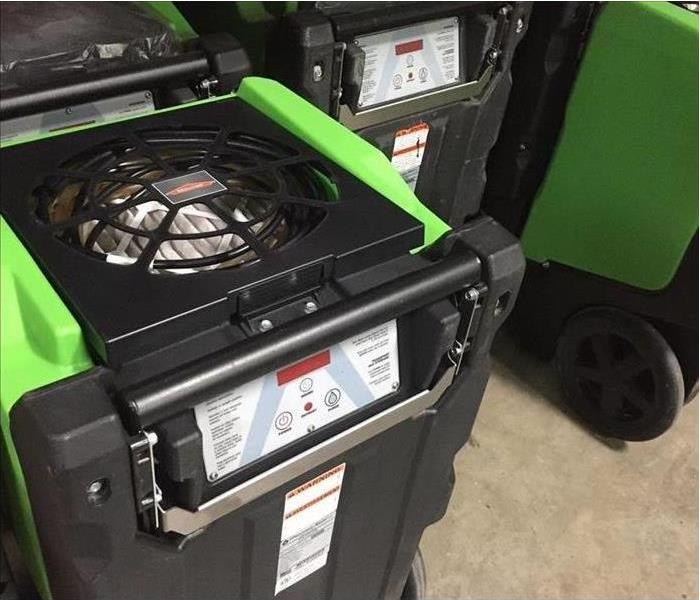 Our team member make sure to come prepared with all the necessary equipment to get the job done in a timely manner.
Our team member make sure to come prepared with all the necessary equipment to get the job done in a timely manner.
We use dehumidifiers as one piece of equipment during our balanced drying system we utilize when we are cleaning up after a water loss. Dehumidification helps to minimize secondary damages. Dehumidifiers used alone are not the only piece of equipment we use. These units are used to capture evaporated moisture in the air. Our team members work to get the moisture out of the material, and they then use air movers and energy to get the water to evaporate. Once evaporated, the vapor can be removed from the air with a dehumidifier. "Dehumidifiers are a sealed refrigeration system with defrost mechanism, fan, and water collection system. The dehumidifier removes energy from the incoming air, then returns this energy as sensible heat to the exiting air. During this energy removal process, water vapor condenses on the evaporator (cool) coil and is collected." - Disaster Academy Training Manual
How to Prepare Your Home for Winter Weather
9/18/2020 (Permalink)
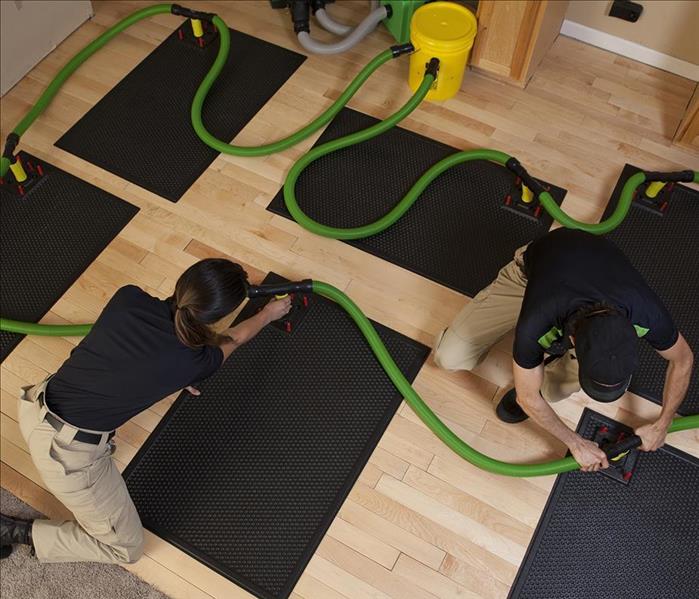 If water damage does occur in your home, you can call on our SERVPRO team to help quickly and efficiently set up equipment for you.
If water damage does occur in your home, you can call on our SERVPRO team to help quickly and efficiently set up equipment for you.
About 1 in 50 homes has a claim caused by water damage or freezing each year. With winter right around the corner now is the perfect time to start preparing your home for the winter weather. SERVPRO has some tips to help you prepare.
- Shut off and drain any outside faucets.
- Once the leaves have fallen, it’s time to clean those gutters.
- Make sure the soil around your home hasn’t settled, leaving areas for water to pool at your foundation.
- Test that your sump pump is in working order.
- Mark your main water source and make sure your family know how to shut it off in case of a water emergency.
If disaster strikes your home, call you local SERVPRO Franchise Professionals to help assist you. We are HERE TO HELP.
Call Us for Water Damage Cleanup
7/15/2020 (Permalink)
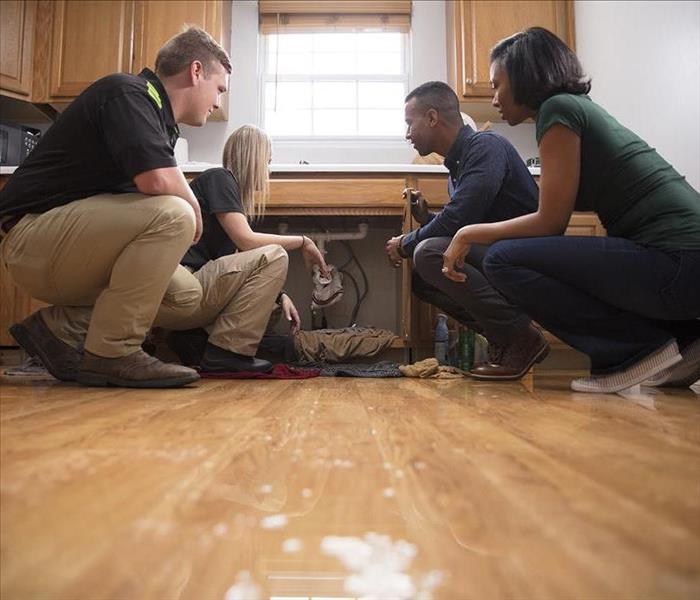 We as franchise professionals work to keep you informed with every part of the process, so you know how to protect your home in the future.
We as franchise professionals work to keep you informed with every part of the process, so you know how to protect your home in the future.
When water damage occurs it can set you in a fit of panic. It is essential to know where your main turn off switches are is very important in a water damage situation. When you see water turn off the main valve first. Then go back and work to isolate where the problem is originating from and you can isolate the leak to the nearest shut off. Water damage can range from burst pipes, natural disasters, flooding, ground infiltration, or even sewer lines. Regardless of the cause another key thing is to know when you need help and it is too much for you to handle. Often times a restoration and cleanup professional is called to help with the restoration. We at SERVPRO of Iowa City/Coralville follow highly regulated processes to ensure that the water damage restoration not only is effective, but also provides a safe place for occupants during and after the restoration process. You can depend on our team of franchise professionals to have the equipment stocked for any situation.
The Do's and Do Not's for Water Damage
7/1/2020 (Permalink)
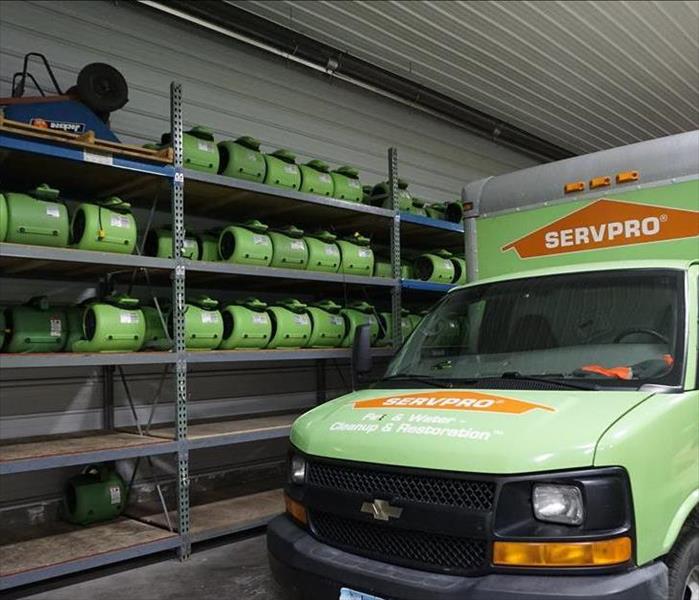 We are fully stocked for any amount of water damage. As franchise professionals, we can help you get toward preloss conditions.
We are fully stocked for any amount of water damage. As franchise professionals, we can help you get toward preloss conditions.
Water damage can happen at any point for anyone, home or business, resulting in sometimes irreversible damaged property. These do's are only for clean water and do not’s pertain to sewage water. Sewage water is treated differently since it causes different damage and requires a different cleanup process. We, the team of SERVPRO of Iowa City/Coralville, know the importance of having professionals helping you properly dry out your home after water damage. With the right tools and pieces of equipment our SERVPRO franchise professionals can safely dry out your home or business and the contents within it. If the proper methods are administered then it minimizes the removal of materials such as drywall (this is also dependent on how soon the water damage is being dealt with. To minimize the damage, make sure to shut off the source of water and turn off the electricity. It is essential to remove as much excess water as possible by mopping and soaking up with towels. This is especially important for wood furniture. To ensure that more damage isn't sustained by the furniture, place aluminum foil in between furniture legs and the carpet. While these are good steps, your safety is important, so make sure to NOT enter a room with standing water since there could be a risk of electrical shock. We take safety very seriously and we want to ensure your safety along with our own. Make sure to disconnect all power first. It is recommended to NOT leave rugs and furniture upholstery wet against one another, because the fabrics have the potential to bleed between each other. It is important to note that you should not be utilizing your household vacuum to try and suck up any water. If these tips are followed, then damage can be minimized and you will be better prepared for help to arrive. Remember to stay safe and get excess water cleaned up professionally to minimize the chance of mold growth.
What Is A Desiccant?
5/27/2020 (Permalink)
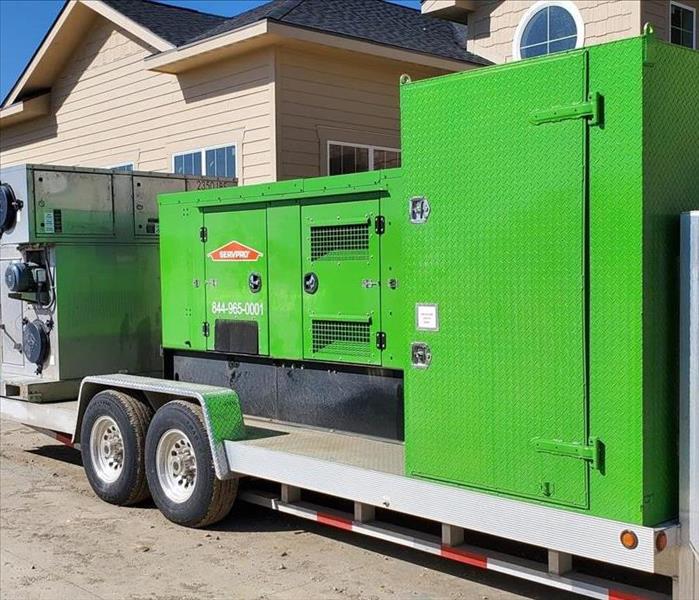 A desiccant can aid in the process in getting a property back to preloss conditions.
A desiccant can aid in the process in getting a property back to preloss conditions.
Our desiccant aids the process of bringing the affected area back to a state of dryness and is mainly used for commercial losses. More specifically, it helps mitigate water damage. For larger scale losses, it acts as a large dehumidifier. It utilizes a generator to help with the process. These use an absorbent material to extract water from the air. The material is heated to drip the moisture into a water tank. Desiccant dehumidifiers are designed to work more effectively in lower temperatures. Dehumidifiers are designed to keep a room’s humidity levels in check, so the air is more comfortable and fewer physical signs of damp air are noticed, helping minimize the chance of mold. The desiccant can be utilized if your home has been flooded, especially if the wood is soft to the touch in that area. Softwood can indicate rotting and windowsills are particularly vulnerable. If you notice mold or mildew our team can use the desiccant to help get the moisture in the air and materials to a more stable level. Desiccants are used on a larger scale water loss to remove moisture from the air. We used these as a tool in our balanced drying system in place or alongside dehumidifiers on a larger scale project. Desiccants operate differently than dehumidifiers. Desiccants do not collect water through condensation. They vent moisture-laden air from inside the structure to outside the structure using a ventilation system. Desiccants are usually large units and sit outside the structure with venting tubes and air input tubes from and to the structure. They create the greatest vapor pressure and are best used when trying to dry wood flooring, plaster, or concrete. They work on the principle of sorption rather than condensation. Water vapor in this process is adsorbed by a silica gel and then that silica gel is reactivated by energy causing the desiccant to release its moisture to the outside air.
How To Handle Water Damage
2/18/2020 (Permalink)
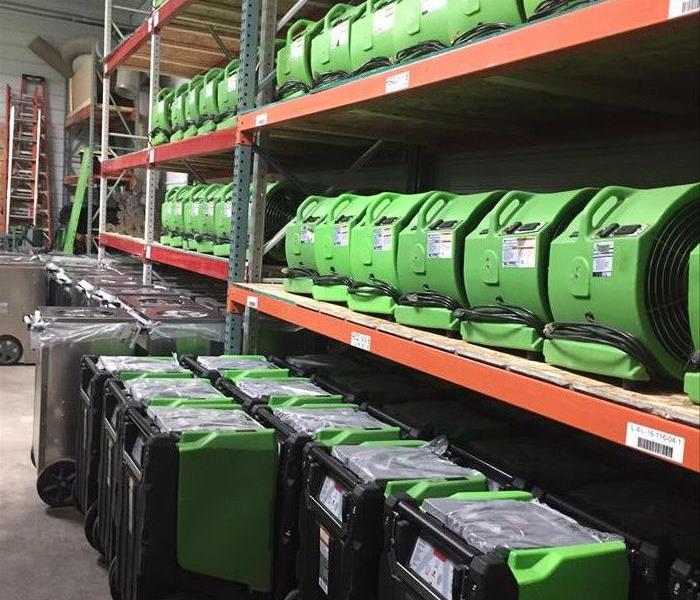 When water damage is out of your control, you can call on our team and we will come with all the needed equipment.
When water damage is out of your control, you can call on our team and we will come with all the needed equipment.
Water damage can happen at any point for anyone, resulting in sometimes, irreversible damaged property. These do's are only for clean water and does not pertain to sewage water. Sewage water is treated differently since it causes different damage. We, the team of SERVPRO of Iowa City/Coralville, know the importance of having professionals helping you properly dry out your home after water damage. With the right tools and pieces of equipment our team can safely dry out your home or business and the products within it. If the proper methods are administered then it minimizes the removal of materials such as drywall (this is also dependent on how soon the water damage is dealt with. To minimize the damage on your property, make sure to shut off the source of water and turn off the electricity. It is essential to remove as much excess water as possible by mopping and soaking up with towels. This is especially important for wood furniture. To ensure that more damage isn't sustained by the furniture, place aluminum foil in between furniture legs and the carpet. While these are good steps, your safety is important, so make sure to NOT enter a room with standing water since there could be a risk of electrical shock. Make sure to disconnect all power first. You shouldn’t leave rugs and furniture upholstery wet against and sitting on carpets, because the fabrics have the potential to bleed between each other. It is important to note that you should not be utilizing your household vacuum to try and suck up any water. If these tips are followed, then damage can be minimized and you will be better prepared for help to arrive. Remember to stay safe!
The Power of Flood Cuts
2/12/2020 (Permalink)
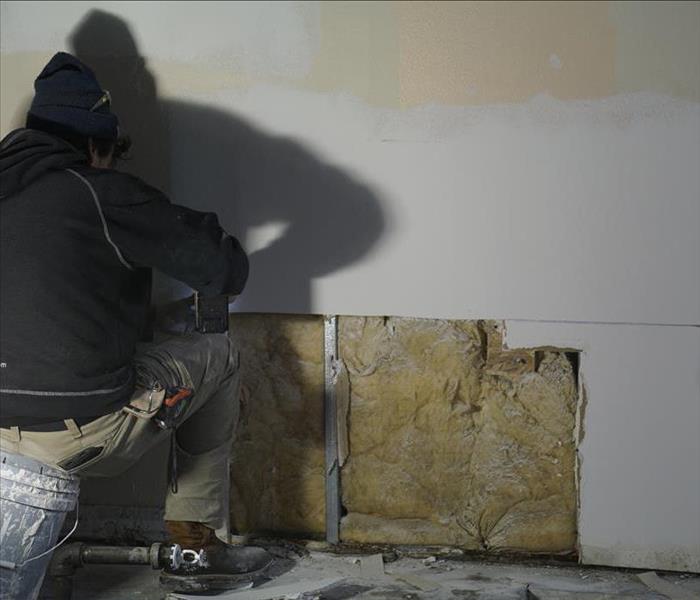 Drywall being removed to make a Flood Cut.
Drywall being removed to make a Flood Cut.
Water damage, if not treated quickly and efficiently, can damage flooring and personal belongings as well as heightening the chance for mold growth. Our Franchise Professionals here at SERVPRO of Iowa City/Coralville are here and “Ready for whatever happens.” With water damaged houses and business, there is a method sometimes needed that is called a Flood Cut. A Flood cut is made from the floor up, cutting out the drywall when you have a water loss. This cut is made at two feet of height. As the water works its way up the drywall, it prevents the water from continuing to move up and makes it easier for reconstruction. Additionally, the insides can be dried and sanitized behind wall cavity. This term is used in water remediation as well as construction for describing partial removal of drywall, allowing access to framing and salvageable materials to continue the drying process. The drywall can easily be fixed, making it look “Like it never even happened.”
Quality Control
10/16/2019 (Permalink)
 Our SERVPRO team comes fully stocked and prepared for water damage disasters.
Our SERVPRO team comes fully stocked and prepared for water damage disasters.
Quality Control
After any water damage, we here at SERVPRO of Iowa City/Coralville, not only take care of getting the water cleaned up but we also preserve the homeowner’s property as this is one of our biggest concerns. Knowing that the homeowner is putting their trust in us, the SERVPRO team makes preparation one of our goals to ensure the highest quality service possible. Listed below are just a few ways we work to achieve top quality control.
- Furniture Blocks: Used to protect surfaces from staining or rusting while the drying process is taking place.
- Safety: Our Technicians are trained to identify and address what could be a possible tripping hazard, just the little extra could prevent an accident.
- Floor Covering: We take the time to cover flooring if necessary, to prevent damage to the homeowner’s floor.
- Keeping the homeowner informed is also one of our top goals, knowing the importance of communicating with the homeowner every step of the way to provide ease of mind that resolution is near is key.
Choose a Professional When Water Damage Happens
7/26/2019 (Permalink)
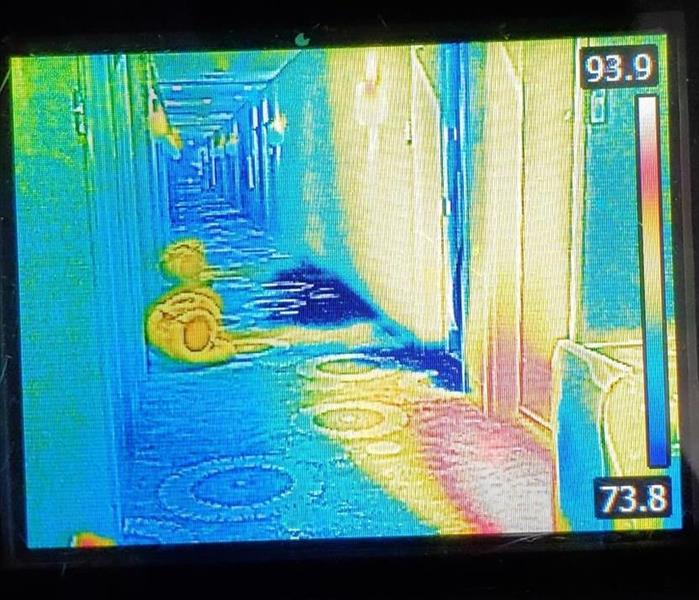 This photo shows the water in dark blue on a FLIR camera, that has migrated through the wall from a water leak on the other side.
This photo shows the water in dark blue on a FLIR camera, that has migrated through the wall from a water leak on the other side.
When water damage occurs it is important to have a mitigation inspect the structure to make sure the structure is in fact dry. It is the water you can't see that can create further damage. Mold. Scary word when you don’t know what it is exactly. To the untrained eye mold or microbial growth as we refer to it can be very intimidating.
Water damage if not properly mitigated can lead to mold. If mold develops choosing the right company for the remediation is key in successfully removing the microbial growth and making sure no spores contaminate the remaining area. Did you know that microbial growth spores are so small that you can’t see them in the air? At SERVPRO of Iowa City / Coralville we use true HEPA Air Filtration Devices and Containment procedures to ensure you and your family or business remain safe. This catches 99.97% of airborne particles and the containment procedures ensure no cross contamination happens. We receive calls all the time where an untrained person has attempted remediation and cross contaminates the unaffected areas putting everyone at risk. At SERVPRO our technicians are certified and we continuously train to stay up to date with all the current procedures, technology, and practices that keep everyone safe. When you choose SERVPRO you can rest assure that you, your family, and your business are in good hands. Below is a link to the EPA’s “Brief Guide to Mold, Moisture, and Your Home.
https://www.epa.gov/sites/production/files/2016-10/documents/moldguide12.pdf
SERVPRO Dries Water Damaged Vehicles Too
6/19/2019 (Permalink)
What happens if you leave your car windows down and now you have water damage in your vehicle. Call SERVPRO of Iowa City / Coralville. Your home, possibly your business and your vehicle are the biggest investments you will make in a lifetime. Due to the risk factor of mold, it is very important to leave the drying process up to SERVPRO if you experience water inside your car. When it comes to your vehicles, SERVPRO uses the same drying process as they would your home or business.
- Identify all affected materials
- Decide what materials should be dried and what should be replaced.
- Measure the restorable materials for moisture content. (How wet is it?)
- Set appropriate drying equipment
- Monitor for progress
- Pulling Equipment when finished.
SERVPRO of Iowa City / Coralville has the equipment necessary to find the hidden water throughout the vehicle that may be trapped between the metal framing of the car and the interior components. We have the knowledge, training, tools, and equipment to get it dried out and get you back on the road in a safe and comfortable vehicle.
What To Do If You See Water
6/14/2019 (Permalink)
When water damage occurs it can put you in a sense of panic. Being calm is key. Knowing where your main turn off switches are is very important in a water damage situation. When you see water turn off the main valve first. Then go back and try and isolate where the problem is coming from and you can isolate the leak to the nearest shut off. Water damage can range from burst pipes, natural disasters, flooding, ground infiltration, or even sewer lines. Regardless of the cause another key important thing is to know when you need help. Often times a restoration professional is called to help with the restoration. We at SERVPRO of Iowa City / Coralville follow highly regulated processes to ensure that the water damage restoration not only is effective, but also provides a safe place for occupants during as well as after the restoration process. You can depend on our team to have the equipment needed for any situation.
Different Types of Water Damage Categories
6/12/2019 (Permalink)
Do you know the difference in water losses? There are three different categories that a water loss is classified in depending on the category of water. These help us determine the best plan to make your water loss “Like it never even happened.” SERVPRO of Iowa City / Coralvilles trained technicians will diagnosis the type of water category depending on the source of the water damage.
Category 1 Water - Refers to a source of water that does not pose substantial threat to humans and classified as "clean water". Examples are broken water supply lines, tub or sink overflows or appliance malfunctions that involve water supply lines.
Category 2 Water - Refers to a source of water that contains a significant degree of chemical, biological or physical contaminants and causes discomfort or sickness when consumed or even exposed to. Known as "grey water". This type carries microorganisms and nutrients of micro-organisms. Examples are toilet bowls with urine (no feces), sump pump failures, seepage due to hydrostatic failure and water discharge from dishwashers or washing machines.
Category 3 Water - Known as "black water" and is grossly unsanitary. This water contains unsanitary agents, harmful bacteria and fungi, causing severe discomfort or sickness. Type 3 category are contaminated water sources that affect the indoor environment. This category includes water sources from sewage, seawater, rising water from rivers or streams, ground surface water or standing water. Category 2 Water or Grey Water that is not promptly removed from the structure and or have remained stagnant may be re classified as Category 3 Water.
You can depend on us to help navigate this to properly mitigate and restore your home or business.
When Water Damage Occurs
5/21/2019 (Permalink)
SERVPRO of Iowa City / Coralville believes safety is your first priority.
1. Never touch or use any electrical appliances or equipment if you are standing on wet carpet or floors.
2. If possible stop the water flow to prevent further damage know where shut off valves are located.
3. Do not throw anything away and take lots of photos and move wet items to a dry area as soon as you can.
4. Try to clean up as much standing water as possible and set up or turn on fans. This can also help circulate air to help with the drying process.
SERVPRO knows that the first 24/48 hours are critical to the restoration process in order to prevent mold damage which can be much more costly to repair then just cleaning up the water and properly drying the structure as well as affected materials.
Moisture Checks for Water Damage
2/20/2019 (Permalink)
It is the water that you don't see that can cause damage. SERVPRO of Iowa City/Coralville uses some of the best meters, detectors, and monitoring devices on the market to protect your home or business when water damage occurs. To make sure that the structure is dry and proper moisture progression is taking place we use these tools when drying a structure. We do daily monitoring while drying a structure as well as will provide moisture checks for residences and commercial locations that have had water infiltration to make sure that the structure is dry and there is not water hiding behind structural materials. This picture shows a infrared camera, called a, FLIR camera. This camera is showing where there is water still trapped in below the flooring material. When you have water damage you can depend on SERVPRO to have the right tools to make sure your structure is properly dry.
Hard Wood Floor Damage
2/20/2019 (Permalink)
When you have hard wood floor damaged by water you can depend on SERVPRO of Iowa City/Coralville to have the specialty drying systems needed to be able to help possibly restore your flooring. Hard wood floor drying systems include mats, air movers, and dehumidification equipment to be able to remove the water trapped by the flooring. The trick to being able to save the flooring is speed. Quick extraction of standing water and quick setting of the floor system is key. If too much warping of the wood has taken place it is hard to bring the wood back to its original state. When water damage occurs to any hard wood flooring it is best to call SERVPRO and have them do a moisture check of the floor and make sure the flooring is dry and there is not any unwanted moisture trapped under the floor to prevent further damage days later. SERVPRO has the equipment for residential losses or even large commercial wood floors like those that are installed in gymnasiums.
Water Damage Clean Up Requires Air Flow
7/25/2018 (Permalink)
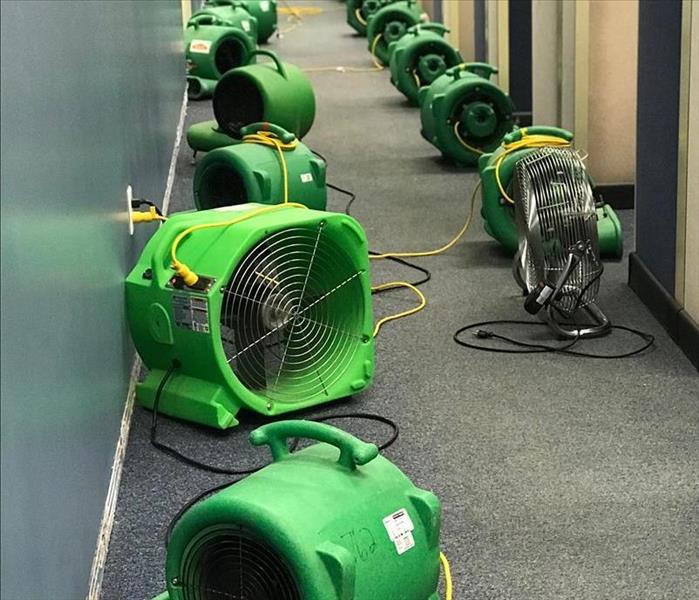
When your business or home are affected by water damage and you don't know what to do you can trust that SERVPRO of Iowa City/Coralville has the equipment necessary to provide the mitigation services you need. When you find water damage call our office right away and we will be out to provide a plan of action and start providing services to stabilize the structure to minimize any further damage from occurring. A big part of properly mitigating a water damage is air flow and providing the right amount of air flow for the affected square footage. With our trained technicians taking measurements and assessing the situation this is figured out. We can then provide the right amount of equipment to properly mitigate the situation. This picture shows a few different types of air movers we have on the same job and how we affectively space them to provide airflow to affected materials. The metal silver fan in the front corner is the clients on this job. You can see the difference on this job of what was actually needed for air flow.
Drying Up After Water Damage
6/28/2018 (Permalink)
When water affects your business or home SERVPRO of Iowa City/Coralville is here to help with equipment and trained staff.
This business had water damage after a heavy rain storm in a short amount of time. The water came into their building and affected the entire location. We extracted the standing water and set equipment. We set a total of 387 fans on this particular job, as well as desiccants and generators as you can imagine it took lots of power to run all this equipment. We have the means to be able to dry the structure. Air flow is a big part of the drying process. Having the right amount of air flow is crucial to the drying process. We use calculations to figure the right amount of equipment needed to properly dry the structure and contents in a facility. We are here to help you with our trained professionals when disaster happens to get you back to your home and business faster, making it "Like it never even happened."
Water Removal after Storm
6/14/2018 (Permalink)
 Crew loading up their van.
Crew loading up their van.
Today in the Iowa City/Coralville area we received a very large amount of rain in a short amount of time. Our crews as soon as the rain started falling in central Iowa were making sure the trucks were loaded and ready. This happens every day though. We make sure we are ready to help when the help is needed. We are able to dispatch the teams quickly to your home or business. We can help you extract the water when your sump pump fails, water infiltrates your foundation, or your sewer backs up. We can dry the structure of the building or even do demo of the affected materials so that the reconstruction can start that much quicker. It is all about getting you back to normalcy as quickly as possibly. Disasters happen but it doesn't have to be that way for long. Let the professionals help.
April Showers bring May flowers and the possibility of flooding to your Iowa City/ Coralville home.
4/4/2018 (Permalink)
April Showers do bring May flowers but they also bring flooding. Taking precautions can help minimize the damage that occurs at your home. The first thing you need to do is check with your insurance to make sure that you are covered. Coverage options vary depending on the insurance company so it is always a good idea to check and see what is available to you. Second, have your sump pump and chimney checks yearly and make sure your gutters are clean and attached properly. If water does get into your home it needs to be removed quickly and dried out properly so you don’t have mold growth in the future. SERVPRO of Iowa City/ Coralville will respond to the problem and extract the water and start the remediation process to prevent mold growth at all affected levels.
"We're all mad here."
2/15/2018 (Permalink)
When you have severe water damage at your home you might go MAD trying to coordinate everything with insurance, mitigation, content cleaning, and then you might have to worry about reconstruction. One thing that you might not think about is all of your important documents and pictures that might have been damaged. You wouldn’t want your marriage license or your Great Grandma’s bible to grow mold because you forgot it had gotten wet in all the hustle of the water damage. We can dry your books, pictures, paintings, and important documents for you.
The Mad Hatter said “No wonder you’re lat. Why, this watch is exactly two days slow.” You don’t have to worry about our clocks being slow because we are a 24/7 company.
Let us help keep the romance lit in Iowa City/Coralville
2/12/2018 (Permalink)
 SERVPRO of Iowa City/Coralville is working to ensure that your romantic plans don't get interrupted.
SERVPRO of Iowa City/Coralville is working to ensure that your romantic plans don't get interrupted.
You have been planning this day out for weeks. The flowers have been delivered, the table is set, and the wine is poured. You are sitting down with your significant other for a romantic candlelit dinner at home. Right before you put dessert on the table you get a smell of something very unpleasant. You search your home to find where the stench is coming from and it is a sewage backup in your bathroom. Sewage back up can occur for a variety of reasons. Don’t let it ruin your romantic night in. You won’t want to clean up the mess yourself put your trust in SERVPRO of Iowa/Coralville and give us a call. We will come in, extract the water, deodorize, clean your damaged contents, and restore carpets and floors.
Call us today to help make sure your romantic night can resume. We work hard to make it "Like it never even happened."
Water Clean Up In Iowa City/Coralville and Surrounding Areas
7/25/2017 (Permalink)
When water damage happens in Iowa City and Coralville and the surrounding areas don't hesitate with who to call. Call SERVPRO of Iowa City/Coralville, Ottumwa/Oskaloosa, Des Moines East & SW. We are the largest SERVPRO in the state of Iowa but we are here to handle everything from a small water leak to a large flood. We can clean up fresh water from a water line break from a washing machine, dish washer, sink, refrigerator, or even water from an air conditioner condensate line. We can clean up water that has backed up from a drain line or from a sump pump that has quit working.
It is so important to call us right away. It is the water you don't see that can cause the most damage. We do free estimates and free moisture checks. Don't hesitate to call.
We have equipment loaded and ready to go and crew that works 24 hours a day to help you and respond to your loss right away to start extracting water and we will set dehumidifiers and air movers if needed as soon as we can to keep the water from wicking further into the structure.
You can trust us. With our three locations to have staff ready to help you 24 hours a day. So when you have water to clean up we are here to help you. Thank you for trusting us.
Emergency Water Tips
6/22/2017 (Permalink)
Suffering a water loss can be a hectic and stressful time. Emotions run high and often times you don’t even know where to start! The first step should always be to identify the source of incoming water then shutoff or stop the water source if possible. Next make sure to turn off all electrical appliances around the affected area to reduce electrical hazards and turn off the circuit breakers supplying electricity to the wet areas. You will want to remove excess water by mopping or blotting and make sure to never use a regular vacuum to remove water! Keep furniture safe from additional damage by placing aluminum foil or wood blocks between furniture legs and wet carpeting/flooring and make sure to call your local SERVPRO to come assess the damage and get the drying process started immediately.
Water Removal From Carpet in Iowa City
6/12/2017 (Permalink)
 Our employee, Nick, extracting water from carpet and pad.
Our employee, Nick, extracting water from carpet and pad.
After a water intrusion we will use this type of equipment to remove the water from carpet and pad. In order to save the carpet and pad it must be a clean water loss. Meaning the leak had to come from a fresh water line. We use this equipment or something similar to extract the water. This machine is called a rover but we will also use a machine called a hydroX. They work the same way. You stand on both types of machines and the weight of the machine and the employee standing on the machine helps to squeeze out and suck up the water. The machine is self propelled using controls on the handle. The water is then pumped through tubes into a truck mounted holding tank to be disposed of. Air movers and dehumidifiers are still needed to remove moisture but this will remove the majority of excess water. We attempt when ever possible to save the carpet and pad but many times if not attended to fast enough delamination occurs. This is why it is so important to know who to call if you ever have water damage and to do it right away. This will minimize cost for the dry out process and minimize property damage.
Dehumidifiers
5/4/2017 (Permalink)
We use dehumidifiers as one piece of equipment during our balanced drying system we use when we are cleaning up after a water loss. Dehumidification helps to minimize secondary damages. Dehumidifiers alone are not the only piece of equipment we use. These units are used to capture evaporated moisture in the air. We have to get the moisture out of the material and we use air movers and energy to get the water to evaporate. Once evaporated the vapor can be removed from the air with a dehumidifier. "Dehumidifiers are a sealed refrigeration system with defrost mechanism, fan, and water collection system. The dehumidifier removes energy from the incoming air, then returns this energy as sensible heat to the exiting air. During this energy removal process, water vapor condenses on the evaporator (cool) coil and is collected." - From Disaster Academy Training Manual
Desiccants
5/4/2017 (Permalink)
Desiccants are used on a larger scale water loss to remove moisture from the air. We used these as a tool in our balanced drying system in place or along side dehumidifiers on a larger scale project. Desiccants operate differently then dehumidifiers. Desiccants do not collect water through condensation. They vent moisture-laden air from inside the structure to outside the structure using a ventilation system. Desiccants are usually large units and sit outside the structure with venting tubes and air input tubes from and to the structure. They create the greatest vapor pressure and are best used when trying to dry wood flooring, plaster, or concrete. They work on the principle of sorption rather then condensation. Water vapor in this process is adsorbed by a silica gel and then that silica gel is reactivated by energy causing the desiccant to release its moisture to the outside air.
Can We Save Your Structure
5/4/2017 (Permalink)
In a lot of cases yes we can. A lot of building materials are made to get wet but NOT maintain wetness. It is very important to have a balanced drying system and start that system very quickly after water damage. Problems with saving materials occur when the water infiltration is caused by contaminated water.
Drywall can be saved if it is a clean water infiltration. Drywall is fragile when wet but when dried it is very strong. If seems are intact and there is no swelling or microbial growth then the drying process can begin.
Paneling and wallpaper are difficult to dry but cavity drying systems can be attempted if the material can not be replaced and it was a clean water infiltration.
Lath and Plaster require a very controlled drying process with aggressive evaporation and low humidity air but can sometimes be saved.
We use many different systems to dry different materials in different spaces. We have floor drying systems, cavity drying systems, and general drying systems.
We are here to help you. Like it never even happened.
Water Damage Do's and Don'ts
2/23/2017 (Permalink)
Water damage from clean water is much different then contaminated, sewer water. These do's are only for clean water. It is important to hire a professional to help you dry out your home after water damage. With the right tools and pieces of equipment we can properly and safely dry out your home or business and the products with in it.
Do's
-Shut off the source of the water.
-Turn off electricity
-Remove as much excess water as possible by mopping and soaking up with towels.
-Wipe excess water from wood furniture.
-Put aluminum foil in between furniture legs and carpet.
Don'ts
-Enter a room with standing water. There could be a risk of electrical shock. Disconnect all power first.
-Leave rugs and furniture upholstery wet against and sitting on carpets. The fabrics could bleed between each other.
-Turn on your television or any other electronic.
-Do not use your household vacuum to try and suck up any water. They are not made for this.
Frozen Pipes
1/6/2016 (Permalink)
Please keep an eye out on your pipes with this incoming cold weather! Leave a few faucets with a very slight drip so there is water moving through the pipes. This will make it less likely for the pipe to freeze. If you do happen to have a frozen pipe, please thaw slowly to prevent the pipe from breaking.
What To Do About Frozen Pipes
1/5/2015 (Permalink)
Frozen pipes can cause a lot of issues and cost a lot of money! One pipe burst in a home at 4-8 gallons of water running per minute can cause thousands of dollars worth of water damage. If not taken care of and mitigated properly this can then lead to mold issues.
Prevention:
- Locate and identify any and all shut off valves in the home and make sure they work properly. (Everyone should know where their "Main Water Valve" is at and how to operate it)
- Identify any potential problems. (Areas where pipes are on an outside wall, ceiling, attics, crawl spaces, etc)
- Seal any gaps around the home wherer cold air has a chance to come in contact with pipes. In extreme cold temperatures, ecspecially wind driven, even a tiny opening can let enough cold in to cause a pipe to freeze. (Dryer vents, windows, cable penetrations, etc.)
- Turn off and drain all standard outside hose bibs.
When the temperature is expected to drop:
- Open kitchen sink and any vanity doors of the areas that are at risk for problems.
- With pipes that are on outside walls that may be a freeze problem, leave a small trickle of both of the hot and cold water running.
- Temporarily seal off any crawl space vents that may be around the foundation.
- Keep the house warm.
What to do if you experience a frozen pipe: (The first sign of a "frozen" pipe is reduced or no flow at all)
- If you experience a "no flow" situation (First turn off the "Main Water Valve" to the house and leave the faucets "open", Second DO NOT use any open flame to attempt to thaw the pipes, Third DO NOT use any electric heater, hair dryer applied directly to the piping as any leaking water may cause electrocution, and Forth turning the water back on is best handled with (2) people. One person turning on the water SLOWLY and the other walking about the house to be sure no water is running).
- Heat and patience is the best way to get frozen pipes thawed out. We do recommend that if a frozen pipe happens to find the source and correct it so it will not happen again. (If you were lucky enough for the frozen pipes not bursting this time, you may not be so lucky the next time.)
**Please be advised if the water to your house is shut off, it may also turn off any fire prevention system you may have hooked up to your water
What to do if you leave your home during the winter months:
- Turn the Main Water Valve off to your home**
- Leave the heat on to the house and set it NO LOWER than 60 degrees.
- Have a neighbor stop by daily, ecspecially when the temperatures are in the 20's or lower.
**If your home has "hot water and/or steam heat", the water must remain on even when you are not there. A neighbor stopping by is critical if this applies to you.





 24/7 Emergency Service
24/7 Emergency Service




















